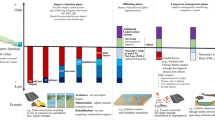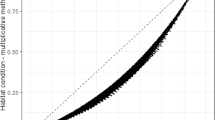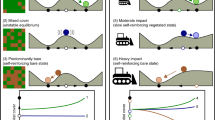Abstract
Biodiversity offset programs attempt to minimize unavoidable environmental impacts of anthropogenic activities by requiring offsetting measures in sufficient quantity to counterbalance losses due to the activity. Multipliers, or offsetting ratios, have been used to increase the amount of offsets to account for uncertainty but those ratios have generally been derived from theoretical or ad-hoc considerations. I analyzed uncertainty in the offsetting process in the context of offsetting for impacts to freshwater fisheries productivity. For aquatic habitats I demonstrate that an empirical risk-based approach for evaluating prediction uncertainty is feasible, and if data are available appropriate adjustments to offset requirements can be estimated. For two data-rich examples I estimate multipliers in the range of 1.5:1 – 2.5:1 are sufficient to account for the uncertainty in the prediction of gains and losses. For aquatic habitats adjustments for time delays in the delivery of offset benefits can also be calculated and are likely smaller than those for prediction uncertainty. However, the success of a biodiversity offsetting program will also depend on the management of the other components of risk not addressed by these adjustments.



Similar content being viewed by others
Notes
Applications for Authorization under Paragraph 35(2)(b) of the Fisheries Act Regulations (SOR/2013-191)
References
Allen PD, Chapman DJ, Lane D (2005) Scaling environmental restoration to offset injury using habitat equivalency analysis. In: Bruins RF, Herberling TF (eds) Economics and ecological risk assessment: application to watershed management. CRC Press, Baton Rouge
Bérubé M, Verdon R, Durocher G, Guay J-C (2005) A comprehensive framework for assessing changes in fish habitat productive capacity resulting from large hydroelectric projects. Can Sci Adv Sec Res Doc 2005/051
Bradford MJ, Smokorowski KE, Clarke KD, Keatley BE, Wong MC (2016) Equivalency metrics for the determination of offset requirements for the Fisheries Protection Program. Can Sci Adv Sec Res Doc 2016/046
Brown MA, Clarkson BD, Barton BJ, Joshi C (2013) Ecological compensation: an evaluation of regulatory compliance in New Zealand. Imp Assess Proj Appr 31:34–44
Brown MA, Clarkson BD, Barton BJ, Joshi C (2014) Implementing ecological compensation in New Zealand: stakeholder perspectives and a way forward. J R Soc N Z 44:34–47
Bull JW, Suttle KB, Gordon A, Singh NJ, Milner-Gulland EJ (2013) Biodiversity offsets in theory and practice. Oryx 47:369–380
Business and Biodiversity Offsets Programme (BBOP) (2013) To no net loss and beyond: an overview of the business and biodiversity offsets programme. Forest Trends, Washington, DC
Clarke KD, Bradford MJ (2014) A review of equivalency in offsetting policies. Can Sci Adv Sec Res Doc 2014/109
Cochrane JF, Lonsdorf E, Allison TD, Sanders-Reed CA (2015) Modeling with uncertain science: estimating mitigation credits from abating lead poisoning in Golden Eagles. Ecol Appl 25:1518–1533
Curran M, Hellweg S, Beck J (2014) Is there any empirical support for biodiversity offset policy? Ecol Appl 24:617–632
Decker AS, Bradford MJ, Higgins PS (2008) Rate of biotic colonization following flow restoration below a diversion dam in the Bridge River, British Columbia. River Res Appl 24:876–883
DEFRA (2012) Technical paper: the metric for the biodiversity offsetting pilot in England, March 2012 Department for Environment, Food and Rural Affairs. http://wwwdefragovuk/publications
DFO (1986) Policy for the management of fish habitat. Communications Directorate, Fisheries and Oceans Canada, Ottawa, Ontario
DFO (2013) Fisheries productivity investment policy: a proponent’s guide to offsetting. URL http://wwwdfo-mpogcca/pnw-ppe/offsetting-guide-compensation/offsetting-guide-compensation-engpdf
Doyle MW, Shields FD (2012) Compensatory mitigation for streams under the Clean Water Act: reassessing science and redirecting policy. J Am Water Res Assoc 48:494–509
Dunford RW, Hausman JA, Desvousges WS (2004) The use of habitat equivalency analysis in natural resource damage assessments. Ecol Econ 48:49–70
Fonseca MS, Julius BE, Kenworthy WJ (2000) Integrating biology and economics in seagrass restoration: how much is enough and why? Ecol Eng 15:227–237
Frissell CA, Nawa RK (1992) Incidences and causes of physical failure of artificial habitat structure in streams of western Oregon and Washington. N Am J Fish Manage 12:182–197
Gibbons P, Evans MC, Maron M, Gordon A, Le Roux D, von Hase A, Lindenmayer DB, Possingham HP (2015) A gain-loss calculator for biodiversity offsets and the circumstances in which no net loss is feasible Conserv Lett doi: 101111/conl12206
Harper DJ, Quigley JT (2005) No net loss of fish habitat: a review and analysis of habitat compensation in Canada. Environ Manage 36:343–355
Hill T, Kulz E, Munoz B (2013) Compensatory stream and wetland mitigation in North Carolina: an evaluation of regulatory success. Environ Manage 51:1077–1091
Hough P, Robertson M (2009) Mitigation under Section 404 of the Clean Water Act: where it comes from, what it means. Wetl Ecol Manage 17:15–33
ICMM IUCN (2012) Independent report on biodiversity offsets. The Biodiversity Consultancy. wwwicmmcom/biodiversity-offsets
Jones HP, Schmitz OJ (2009) Rapid recovery of damaged ecosystems. PLoS One 4(5):e5653. doi:10.1371/journalpone0005653
Keagy JC, Schreiber SJ, Cristol DA (2005) Replacing sources with sinks: when do populations go down the drain? Restor Ecol 13:529–535
Kendall MG, Stuart A (1963) The advanced theory of statistics Volume 1, distribution theory. Charles Griffon Co, London
Kondolf GM, Anderson S, Lave R, Pagano L, Merenlander A, Bernhardt ES (2007) Two decades of river restoration in California: what can we learn? Restor Ecol 15:516–523
Laitila J, Miolanen A, Pouzols FM (2014) A method for calculating minimum biodiversity offset multipliers accounting for time discounting, additionality and permanence. Methods Ecol Evol 5:1247–1254
Lennox MS, Lewis DJ, Jackson RD, Harper J, Larson S, Tate KW (2011) Development of vegetation and aquatic habitat in restored riparian sites of California’s North coast rangelands. Restor Ecol 19:225–233
Levrel H, Pioch S, Spieler R (2012) Compensatory mitigation in marine ecosystems: which indicators for assessing the “no net loss” goal of marine ecosystem services and ecological functions? Mar Pol 36:1202–1210
Marsaglia G (2006) Ratios of normal variables. J Stat Softw 16(4):1–10
McKenney BA, Kiesecker JM (2010) Policy developments for biodiversity offsets: a review of offset frameworks. Environ Manage 45:165–176
Miller SW, Budy P, Schmidt JC (2010) Quantifying macroinvertebrates responses to in-stream habitat restoration: applications of meta-analysis to river restoration. Restor Ecol 18:8–19
Minns CK (2006) Compensation ratios needed to offset timing effects of losses and gains and achieve no net loss of productive capacity of fish habitat. Can J Fish Aquat Sci 63:1172–1182
Minns CK, Moore JE (2003) Assessment of net change of productive capacity of fish habitats: the role of uncertainty and complexity in decision making. Can J Fish Aquat Sci 60:100–116
Minns CK, Randall RG, Smokorowski KE, Clarke KD, Vélez-Espino A, Gregory RS, Courtenay S, LeBlanc P (2011) Direct and indirect estimates of the productive capacity of fish habitat under Canada’s policy for the management of fish habitat: where have we been, where are we now, and where are we going? Can J Fish Aquat Sci 68:2204–2227
Moilanen A, van Teeffelen AJA, Ben-Haim Y, Ferrier S (2009) How much compensation is enough? A framework for incorporating uncertainty and time discounting when calculating offset ratios for impacted habitat. Restor Ecol 17:470–478
National Oceanographic and Atmospheric Administration (NOAA) (1999) Discounting and the treatment of uncertainty in natural resource damage assessment Technical Paper 99-1, Damage Assessment and Restoration Program, NOAA, Silver Spring MD
Ogsten L, Gidora S, Foy M, Rosenfeld J (2015) Watershed-scale effectiveness of floodplain habitat restoration for juvenile coho salmon in the Chilliwack River, British Columbia. Can J Fish Aquat Sci 72:479–490
Orzetti LL, Jones RC, Murphy RF (2010) Stream condition in Piedmont streams with restored riparian buffers in the Chesapeake Bay watershed. J Am Water Res Assoc 46:473–485
Overton JMcC, Stephens RTT, Ferrier S (2013) Net present biodiversity value and design of biodiversity offsets. Ambio 42:100–110
Palmer MA, Allan JD, Meyer J, Bernhardt ES (2007) River restoration in the twenty-first century: data and experiential knowledge to inform future efforts. Restor Ecol 15:472–481
Parkes D, Newell G, Cheal D (2003) Assessing the quality of native vegetation: the ‘habitat hectares’ approach. Ecol Manage Restor 4:29–38
Pickett EJ, Stockwell MP, Bower DS, Garnham JI, Pollard CJ, Clulow J, Mahony MJ (2013) Achieving no net loss in habitat offset of a threatened frog required high offset ratio and intensive monitoring. Biol Conserv 157:156–162
Pilgrim JD, Ekstrom JMM (2014) Technical conditions for positive outcomes from biodiversity offsets. IUCN, Gland
Quétier F, Lavorel S (2011) Assessing ecological equivalence in biodiversity offset schemes: key issues and solutions. Biol Conserv 144:2991–2999
Quigley JT, Harper DJ (2006) Compliance with Canada’s Fisheries Act: a field audit of habitat compensation projects. Environ Manage 37:336–350
Race MS, Fonseca MS (1996) Fixing compensatory mitigation: what will it take? Ecol Appl 6:94–101
Robb JT (2002) Assessing wetland compensatory mitigation sites to aid in establishing mitigation ratios. Wetlands 22:435–440
Roni P, Morley SA, Garcia P, Detrick C, King D, Beamer E (2006) Coho salmon smolt production from constructed and natural floodplain habitats. Trans Am Fish Soc 135:1398–1408
Rosenfeld JS, Boss S (2001) Fitness consequences of habitat use for juvenile cutthroat trout: energetic costs and benefits in pools and riffles. Can J Fish Aquat Sci 58:585–593
Saenz S, Walschburger T, Gonzalez JC, Leon J, McKenney B, Kiesecker J (2013) A framework for implementing and valuing biodiversity offsets in Colombia: a landscape scale perspective. Sustainability 5:4961–4987
Schlesinger DA, Regier HA (1982) Climatic and morphoedaphic indices of fish yields from natural lakes. Trans Am Fish Soc 111:141–150
Strange EM, Galbraith H, Bickel S, Mills D, Beltman D, Lipton J (2002) Determining ecological equivalence in service-service scaling of salt marsh restoration. Environ Manage 29:290–300
Tallis H, Kennedy CM, Ruckelshaus M, Goldstein J, Kiesecker JM (2015) Mitigation for one and all: an integrated framework for mitigation of development impacts on biodiversity and ecosystem services. Environ Impact Assess Rev 55:21–34
Tischew S, Baasch A, Conrad MK, Kirmer A (2010) Evaluating restoration success of frequently implemented compensation measures: results and demands for control procedures. Restor Ecol 18:467–480
van Katwijk MM, Bos AR, de Jonge VN, Hanssen LSAM, Hermus DCR, de Jong DJ (2009) Guidelines for seagrass restoration: importance of habitat selection and donor population, spreading of risks, and ecosystem engineering effects. Mar Poll Bull 58:179–188
Zedler J, Shabman L, Alvarez V, Evans RO, Gardner RC, Gibbons JW, Gilliam JW, Johnston CA, Mitsch WJ, Prestegaard K, Redmond AM, Simenstad C, Turner RE (2001) Compensating for wetland losses under the Clean Water Act National Academy Press, Washington, DC
Acknowledgements
I thank Bronwyn Keatley, Keith Clarke, Karen Smokorowski, and Melisa Wong of Fisheries and Oceans Canada for their contributions to this project and participants of the Canadian Science Advisory Secretariat’s November 2014 meeting on equivalency metrics for offsetting for discussion. This work was supported by funds provided by the Ecosystem and Ocean Science Sector, Fisheries and Oceans Canada.
Author information
Authors and Affiliations
Corresponding author
Ethics declarations
Conflict of Interest
The authors declare that they have no competing interests.
Rights and permissions
About this article
Cite this article
Bradford, M.J. Accounting for Uncertainty and Time Lags in Equivalency Calculations for Offsetting in Aquatic Resources Management Programs. Environmental Management 60, 588–597 (2017). https://doi.org/10.1007/s00267-017-0892-6
Received:
Accepted:
Published:
Issue Date:
DOI: https://doi.org/10.1007/s00267-017-0892-6




